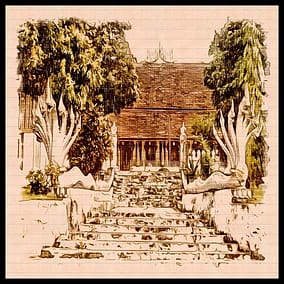
A chance encounter
Such intricate design. The silver serpents gushing forth fans of smaller snake heads were enticing. I took the steps up to the temple complex in this small city in Northern Laos. As I started taking photos I was approached by a young man in an orange robe. I was 18 and happily chatted away to the other teenager. Whilst I was on a six month travelling trip in South-East Asia, he was a ‘novice monk’ learning the ways of Wat Ho Xiang.
At some point a gong sounded calling the resident monks to meditate. My new companion, named Phet, said I could join them and instructed me to reflect on the kindness of my mother while they meditated. A touch random, but okay… just inside the temple entrance, I had a nice think. Further inside, a dozen or so robed monks chanted rhythmically in a language I couldn’t decipher.
Back to his place
Afterwards, Phet showed me his nearby dwellings in the temple grounds which he shared with the other novices. It was cosy, bordering on cramped, and smelled of incense and damp. Robes hung everywhere. There were numerous books scattered about. He recommended I read a book called What the Buddha taught and I said I would if I could get hold of a copy. We chatted for a while and then I left, happy to have made a local friend. A few weeks later I would pick up the mentioned book in a book shop in Thailand.
I went back to see Phet the next day and he was pleased. The year was 2006, there was no social media, and he had no email. So before I left Luang Prabang, I photocopied a postcard I had with me of the Liverpool skyline and wrote a friendly message on the back. I have often wondered if Phet grew up to become a fully fledged monk; whatever that process entails. For his part, he may have met hundreds of wandering Westerners. He may be surprised or pleased to know that Buddhism has had a strong influence on me to this day.
Influences on creative output
Since I adopted the orange colour for this site and CamZhu’s broader ‘branding’ I’ve been occasionally wondering how meditation practices (which I should do more of) and mindfulness practices (which I do quite regularly) affect broader design choices. At the core of Zen Buddhism is the pursuit of Satori, the moment of sudden enlightenment. This spiritual journey involves the realization of the interconnectedness of all things and the impermanence of the self. The practice itself is rooted in meditation and mindfulness. The two concepts that continue to influence me since I read the book Phet recommended all those years ago.
For some Westerners, becoming a Zen Buddhist involves more than adopting a new belief system. It means embracing a lifestyle that emphasizes mindfulness, meditation, and enlightenment in every aspect of life, including fashion. Zen Buddhism is unique for its emphasis on experiential wisdom in the attainment of enlightenment. Also, there is an insistence on non-reliance on sacred texts, and an emphasis on direct experience. I would hardly call myself a card-carrying Buddhist these days. Yet I would hope that my design choices have been altered favourably by my own adoption of Zen notions.
What clothing is worn by a Buddhist?
Fashion, as in the way we choose to dress, style and compose ourselves, says much about our values. So what do Buddhists wear? The answer varies widely. Monastic Buddhist practitioners traditionally wear robes like my young buddy did back in Laos. These are known as Kāṣāya in Sanskrit. The robes, which can also be shades of yellow, saffron, or maroon, tend to signify the renouncement of a materialistic lifestyle. However, lay Buddhists usually dress in comfortable, modest clothing that does not hinder practice.
Which brings us to the question of what should you wear for meditation, a central aspect of Zen Buddhist practice. Regardless of whether you are a seasoned Zen practitioner or a beginner exploring meditation, comfort is key. Go for loose, breathable clothes that don’t restrict movement or circulation. The Buddhism-inspired comfortable clothing in my SpreadShirt shop embodies these principles. My design showcasing the Dharma Wheel, a symbol representing the Buddhist Eightfold Path to enlightenment, adds a touch of spirituality. It also serves as a constant reminder of the journey towards mindfulness and serenity.
Final thoughts
Zen Buddhism offers more than just a philosophical framework; it offers a way of living, thinking, and even dressing that can guide us towards mindfulness and inner peace. Zen-inspired fashion seems kind of a strange concept but essentially, it’s about comfort, simplicity, and embodying the profound principles of this ancient tradition.
Remember, whether it’s meditation, design, or life itself, Zen teaches us to focus on the present moment and experience it fully. By doing so, we can achieve a sense of peace and understanding that extends beyond the aesthetics.
nice article…. gave your blog a like !
Kind Regards Mel
Free Keto Diet Recipes